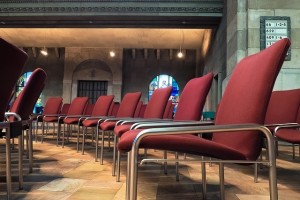Are Your Church’s Assets Properly Insured?
December 30, 2019 - 4 minutes read As well as insurance for your buildings and vehicles, you should make sure you have adequate cover for the general contents and valuable items belonging to your church.
As well as insurance for your buildings and vehicles, you should make sure you have adequate cover for the general contents and valuable items belonging to your church.
You need to insure your contents on a new for old replacement basis. This means that if your computer (for example) was destroyed or stolen, you get to replace it with a new one at current prices.
To correctly insure your items you need to have an accurate value for them rather than an estimate or ‘best guess’.
What sorts of items should you insure?
You should insure all items that have value to your community. This may include:
- Furniture and soft furnishings – e.g. couches, chairs, tables, drapes, floor coverings.
- Church service items – Bibles, pulpit, hymn books, church seating, musical instruments, screens, CD/DVD players.
- Office furniture and equipment – desks, chairs, computers, software, photocopiers, fax machines, office supplies, printers, filing cabinets, bookshelves, indoor plants, desk lamps.
- Appliances – portable heaters and fans, kitchen equipment and utensils.
- Outdoor equipment – gardening equipment, tools, ladders, barbecues.
- Adventure equipment – children’s play equipment, gym or sporting equipment.
- Precious items – such as artworks, antiques or unique items.
- Other – any other items that have value for your organisation. This could include theatre props, specialty lighting, cameras and so on.
4 tips for accurately insuring your assets
1. Maintain a written record of all your inventory
A written record (whether pen-and-paper or electronic) helps you to keep track of all your valued items. It can also help speed up insurance claims for losses. This document should be kept in a fireproof safe or in secure electronic cloud storage.
Your record of items should include details of their location and the approximate cost for replacement (e.g. from catalogs, shops or websites). For electronic hardware, recording serial numbers can help with tracking of items if they get stolen.
It’s important not to draw up your inventory once and then forget about it. You should update your record regularly, including every time you purchase or receive new items or you discard or donate old ones.
To help you with this we’ve put together an inventory form with instructions that can be downloaded from our ‘Forms‘ section (scroll down to find it).
2. Keep additional records
This includes receipts and photos or videos of valuable items as extra backup. Keep paper receipts and physical photos in a fireproof safe and any electronic copies in secure cloud storage.
3. High value items
For very high-value, rare or precious items, get a professional valuation and keep a copy of the valuation certificate in a secure safe or offsite.
4. Add identity marking to your highly valued items
Engraving or identity-marking your high-value items helps with tracking, and it can also make the items harder to sell and therefore less valuable to thieves.
Insurance cover
Contents are covered by a property insurance policy that covers both your building and its contents. To discuss your insurance policy call or email our team.
Futher reading
As well as insuring your contents you need to take steps towards reducing your risk of burglary and theft, fires and other disasters. This also helps reduce your risk of claims and of incurring higher premiums. See our articles below for more information on security and risk management.
Mistakes property owners make when it comes to burglaries
Protecting your community from the effects of vandalism
Tips for crime-proofing your building
Written by Tess
Tags: asset protection, insurance
Recent Comments